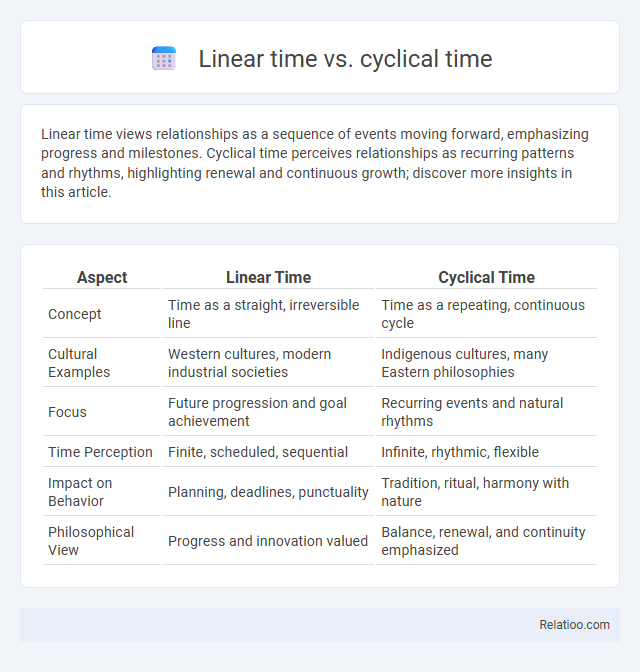Linear time views relationships as a sequence of events moving forward, emphasizing progress and milestones. Cyclical time perceives relationships as recurring patterns and rhythms, highlighting renewal and continuous growth; discover more insights in this article.
Table of Comparison
| Aspect | Linear Time | Cyclical Time |
|---|---|---|
| Concept | Time as a straight, irreversible line | Time as a repeating, continuous cycle |
| Cultural Examples | Western cultures, modern industrial societies | Indigenous cultures, many Eastern philosophies |
| Focus | Future progression and goal achievement | Recurring events and natural rhythms |
| Time Perception | Finite, scheduled, sequential | Infinite, rhythmic, flexible |
| Impact on Behavior | Planning, deadlines, punctuality | Tradition, ritual, harmony with nature |
| Philosophical View | Progress and innovation valued | Balance, renewal, and continuity emphasized |
Introduction to Linear Time and Cyclical Time
Linear time perception views time as a finite sequence of past, present, and future events progressing in a straight, irreversible line, emphasizing deadlines and punctuality. Cyclical time perception considers time as a repeating loop where events and seasons recur, highlighting rhythms, traditions, and natural cycles. Understanding these time orientations aids in cross-cultural communication and decision-making by recognizing how different societies prioritize punctuality, planning, and the flow of time.
Defining Linear Time: A Chronological Perspective
Linear time is understood as a sequential, chronological progression where events follow a fixed order from past to present to future, highlighting cause and effect relationships. This perspective emphasizes deadlines, schedules, and planning, allowing you to measure and organize time precisely for efficient task management. In contrast to cyclical time, which views time as repeating cycles, linear time aligns with modern Western cultural norms prioritizing progress and goal-oriented activities.
Understanding Cyclical Time: The Repeating Pattern
Understanding cyclical time reveals how cultures perceive time as a continuous, repeating pattern of events, contrasting sharply with the linear time view that sees time as a constant, forward-moving progression. Your grasp of cyclical time orientation highlights natural rhythms, seasons, and cultural rituals that emphasize repetition and renewal, influencing behaviors and decision-making in societies valuing harmony with nature. This perspective shapes time orientation by prioritizing cycles over deadlines, fostering a holistic sense of continuity and connection across past, present, and future.
Historical Origins of Linear and Cyclical Time Concepts
Linear time originates from ancient Semitic cultures and Judeo-Christian traditions, emphasizing a chronological progression with a defined beginning and end. Cyclical time, rooted in Hinduism, Buddhism, and indigenous traditions, reflects recurring natural patterns such as seasons and reincarnation cycles. Time orientation studies how cultures perceive past, present, and future, influencing social behavior and historical consciousness.
Philosophical Implications of Time Perception
Linear time conceptualizes existence as a continuous, irreversible progression from past to future, emphasizing causality and historical development in your understanding of reality. Cyclical time views events as recurring in infinite loops, reflecting natural rhythms and fostering a philosophy centered on renewal and eternal return. Time orientation shapes how you perceive temporality, influencing cultural values, decision-making, and the existential meaning attributed to life's flow.
Linear Time in Western Thought and Culture
Linear time in Western thought emphasizes a sequential progression from past to present to future, highlighting cause-and-effect relationships and prioritizing deadlines, schedules, and productivity. This time orientation shapes cultural values around punctuality, goal-setting, and forward planning, influencing how you organize your daily activities and long-term ambitions. Contrasting with cyclical time concepts found in other cultures, the linear perspective drives a future-focused mindset that values progress and innovation.
Cyclical Time in Eastern Traditions and Beliefs
Cyclical time, predominant in many Eastern traditions and beliefs such as Hinduism and Buddhism, emphasizes recurring patterns and the eternal return of life, seasons, and cosmic events, contrasting sharply with the linear time concept common in Western thought. This time orientation influences rituals, worldview, and personal growth, where Your experiences are seen as part of an ongoing cycle of birth, death, and rebirth, promoting harmony with natural rhythms. Understanding cyclical time helps in appreciating cultural narratives that prioritize balance, continuity, and the interconnectedness of all existence.
Scientific Views: Time in Physics and Cosmology
Linear time in physics is often defined as a continuous, unidirectional sequence from past to future, essential for understanding entropy and the arrow of time in thermodynamics. Cyclical time appears in cosmological models such as oscillating universe theories, where time undergoes repeated cycles of expansion and contraction, contrasting with the linear progression but lacking empirical consensus. Your comprehension of time orientation deepens by analyzing how physics integrates time as a dimension within spacetime frameworks and cosmology's evolving models, reflecting both the linear flow and potential cyclical patterns.
Impact on Society: Time in Daily Life and Rituals
Linear time, characterized by a sequential progression from past to future, shapes societies with a focus on deadlines, productivity, and goal-oriented behaviors. Cyclical time, often embraced in agricultural and indigenous cultures, emphasizes repetition, seasons, and rituals that foster community cohesion and respect for natural cycles. Time orientation influences societal norms, where linear perspectives drive punctuality and efficiency, while cyclical views encourage rhythm, tradition, and collective participation in ceremonies.
Comparing Linear and Cyclical Time: Key Differences and Insights
Linear time is perceived as a continuous, irreversible progression of events from past to future, emphasizing schedules and deadlines, while cyclical time revolves around repeating patterns and natural rhythms, such as seasons and life cycles. Your understanding of time orientation impacts how you prioritize goals, manage tasks, and interpret experiences within cultural or personal frameworks. Key differences include the value placed on punctuality in linear time and the acceptance of recurrence and renewal in cyclical time, shaping behavior and decision-making.

Infographic: Linear time vs Cyclical time
 relatioo.com
relatioo.com